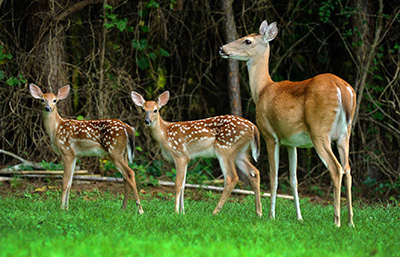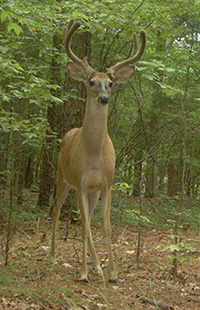The Dawn of New Lawn Fawns
The Dawn of New Lawn Fawns
By the Site Ecology Team (SET) and Wildlife and Industry Together (WAIT)
May 1, 2015

Photo courtesy of Steve McCaw
As you may recall, white-tailed deer were in rut last fall (mid-October into November). This period marked the start of a new beginning. Now with May already here, the end of the deer’s gestational period has come.
Both males (bucks, stag) and females (does) reach maturity by 1.5 years. Females can breed earlier but the outcome is considered good if one fawn survives. Once mature, does can fawn yearly, producing 1-4 fawns, (2 is most common) until the female dies. In the wild, males on average live 2-5 years while females 3-6 years. Since bucks are polygamous, does with large litters have often bred with multiple males. Animal nutrition plays an important part in both litter size and fawn health.
At birth, the fawns have no odor and will be able to move around within hours. This is good, for the mother needs to move them away from the birthing site. The fawn’s spots help them blend into their surroundings, allowing it to “hide”. It is common for the fawn to be left alone while the female browses. She returns to nurse then leaves to feed. People sometimes come upon a fawn and believe it to be lost or abandoned. Wrong! Most of the time, the female may just be out of sight and people put themselves in harms way by approaching young animals. The instinct to protect young is very strong in deer and they should be allowed more space during fawning season. In other words, that’s NOW. Although the fawns could be weaned after 4 months, they will stay with their mother for the first year (teenagers).
If a fawn is in obvious danger on campus, contact the NIEHS Security Office at 919-541-7515 who will relay that information to the Institute veterinarians and they will respond and take the appropriate action. It is illegal to remove a fawn from the wild.
It’s not unusual to see a fawn near Discovery Lake walkway or lying near the sidewalk between the South Parking Lot and the Building 101. Please exercise caution so we all can enjoy deer sightings without an adverse incident.
Some Fawn Facts

Photo courtesy of Katie Pelch
- Does drop their fawns approximately 200 days after conception
- Fawns average 6-8 lbs. at birth
- Does bred as fawns (last year’s) typically have a single fawn
- Does bred as 1.5 year old and older typically have twins and occasionally triplets
- Newborn fawns typically can stand and nurse within 30 minutes
- Fawns are capable of walking within a few hours
- Does generally move their fawns away from the birthing site within 3 hours
- Does with twins typically stash them in thick cover in separate locations
- Does usually remain within 100 yards of their fawns
- Fawns spend 90 percent of their time bedded for the first weeks of their lives
- Newborn fawns typically nurse 2 to 3 times daily; increasing to 6 to 8 times over time
- Nursing times average 20 to 30 minutes
- A 3-week-old fawn can outrun most danger
- Twins are usually reunited and bed close to each other by 3-4 weeks of age
- Fawns begin eating vegetation at 2-3 weeks of age
- The average number of spots on a fawn is 300
Resources
- Quality Whitetails The Why and How of Quality Management, Drs. Karl V. Miller and R. Larry Marchinton, UG
- "Spotting" Whitetail Deer Fawns
- Whitetail Facts: 16 Things to Know About Fawns



